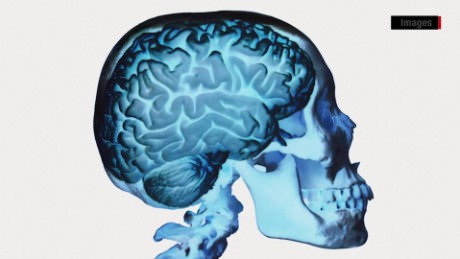For years, the NFL has avoided saying whether football was related to CTE and deferred to the medical community’s findings on the matter.
So why the change now?
What is CTE? 01:55
Previously, the NFL has said that it was waiting on more brain studies, according to CNN’s Coy Wire, who played nine seasons in the league.
“There were simply not enough studies or medical proof for the league to make a direct connection between football and CTE,” Wire said.
However, recent studies at Boston University may have been an impetus for the change in the league’s perspective.
In his response on Monday, Miller referenced Dr. Ann McKee, a neuropathologist and an expert in neurodegenerative disease at Boston University School of Medicine.
“I think certainly, based on Dr. McKee’s research, there’s a link, because she’s found CTE in a number of retired football players,” Miller said. “I think the broader point … is what that necessarily means and where do we go from here with that information.”
“I unequivocally think there’s a link between playing football and CTE,” McKee said Monday. “We’ve seen it in 90 out of 94 NFL players whose brains we’ve examined, we’ve found it in 45 out of 55 college players and six out of 26 high school players. Now I don’t think this represents how common this disease is in the living population, but the fact that over five years I’ve been able to accumulate this number of cases in football players, it cannot be rare. In fact, I think we are going to be surprised at how common it is.”
19 photos: Athletes and CTE
19 photos: Athletes and CTE
Former Minnesota Vikings linebacker Fred McNeill died in November 2015 at the age of 63, due to complications from ALS. However, an autopsy confirmed that he suffered from CTE. What makes McNeill’s case even more remarkable, though, is that he was potentially the first to be diagnosed while alive. Doctors used an experimental new technology to examine his brain.
Scientists believe repeated head trauma can cause CTE, a progressive degenerative disease of the brain. Symptoms include depression, aggression, and disorientation, but so far scientists can only definitively diagnose it after death. Here are a few of the former athletes who have been diagnosed with CTE.
19 photos: Athletes and CTE
One time NFL MVP and Oakland Raiders quarterback Ken Stabler, who died in July, suffered from chronic traumatic encephalopathy, or CTE, researchers at Boston University said Wednesday.
19 photos: Athletes and CTE
Kansas City Chiefs linebacker Jovan Belcher shot and killed his girlfriend before killing himself two years ago. Pathology reports show he likely had CTE.
19 photos: Athletes and CTE
Hall of Famer Mike Webster was the first former NFL player to be diagnosed with CTE. After his retirement, Webster suffered from amnesia, dementia, depression, and bone and muscle pain.
19 photos: Athletes and CTE
The death of 36-year-old Pittsburgh Steelers offensive lineman Justin Strzelczyk put the link between playing football and CTE in the national spotlight. Strzelczyk was killed in 2004 in a car crash after a 40-mile high-speed chase with police in New York.
Evidence of CTE was found in the brain of football player Lew Carpenter after his death in 2010 at the age of 78.
19 photos: Athletes and CTE
Pro Football Hall of Famer Louis Creekmur, who played for the Detroit Lions from 1950 to 1959, suffered decades of cognitive decline before his death.
19 photos: Athletes and CTE
Linebacker John Grimsley of the Houston Oilers died of an accidental gunshot wound to the chest. Analysis of his brain tissue confirmed damage to the neurofibrillary tangles that had begun to affect his behavior and memory.
19 photos: Athletes and CTE
Chris Henry played five seasons for the the Cincinnati Bengals before dying at the age of 26. He died after falling from the bed of a moving pickup during a fight with his fiancée, ending a life plagued by behavioral problems. His young age prompted concern over how quickly athletes start to suffer from CTE.
19 photos: Athletes and CTE
Offensive lineman Terry Long of the Pittsburgh Steelers committed suicide by drinking antifreeze. Although the antifreeze caused swelling of the brain, football-related brain injuries were a contributing factor to his death.
Pro Football Hall of Famer John Mackey suffered from dementia for years before dying at the age of 69.
Ollie Matson played 14 NFL seasons starting in the 1950s and suffered from dementia until his death in 2011.
Andre Waters spent most of his 12 seasons with the Philadelphia Eagles before his suicide at age 44.
Tom McHale of the Tampa Bay Buccaneers, right, died in 2008 of an apparent drug overdose at the age of 45.
Junior Seau took his own life in 2012 at the age of 43. The question of CTE came up immediately after his death; scientists at the National Institutes of Health confirmed the diagnosis in January 2013.
19 photos: Athletes and CTE
Wrestler Chris Benoit was found dead at his suburban Atlanta home along with his wife, Nancy, and son in an apparent murder-suicide. Later testing found that the damage to his brain was similar to that of an elderly Alzheimer’s patient.
Reggie Fleming, who played for six NHL teams, mainly in the 1960s, was the first hockey player to be diagnosed with CTE.
Hockey player Bob Probert was found to have CTE after suffering from heart failure at the age of 45.
Several former NFL players, including some prominent members of the Pro Football Hall of Fame, have been found to have had CTE.
Most recently, Ken Stabler, who died in July from cancer, was posthumously elected to the Pro Football Hall of Fame in February. Earlier that week, researchers at Boston University said that Stabler suffered from CTE.
Hall of Fame class of 2015 member Junior Seau also was elected after his death. He was 43 when he killed himself in May 2012 with a gunshot wound to the chest and was posthumously diagnosed with CTE.
Mike Webster, the Pittsburgh Steelers center who was profiled in the movie “Concussion,” was the first former NFL player to be diagnosed with CTE. He died of a heart attack at age 50.
Perhaps the best-known person diagnosed with CTE was Hall of Famer and revered sportscaster Frank Gifford; he died of natural causes in August at age 84.
The NFL Players Association had no comment on Miller’s statement, but referred CNN to a news release it issued two weeks ago headlined “NFLPA Letting Medical Science Point the Direction in Fight to Protect Players’ Health and Safety.”
What happens with lawsuits?
In June 2015, a federal judge approved a class-action lawsuit settlement between the NFL and thousands of former players. The agreement provides up to $5 million per retired player for serious medical conditions associated with repeated head trauma.
While the lawsuit was a combination of hundreds of actions brought by more than 5,000 ex-NFL players, the settlement applies to all players who retired on or before July 7, 2014, according to Judge Anita Brody’s 132-page decision. It also applies to the family members of players who died before that date.
However, that is all on hold for now. According to the NFL concussion settlement website, “no claims for benefits can be submitted now and none have been submitted. No awards have been issued.”
“We welcome the NFL’s acknowledgment of what was alleged in our complaint: that reports have associated football with findings of CTE in deceased former players,” Christopher Seeger, co-lead counsel for the retired NFL player class plaintiffs, said Tuesday in a statement. “Retired NFL players brought this case to obtain security and care for the devastating brain injuries they were experiencing at a rate much greater than the general population. The settlement achieves that, providing immediate care to the sickest retired players and long-term security over the next 65 years for those who are healthy now but develop a qualifying condition in the future.”
Following Miller’s comments Monday, attorney Steven Molo, who represents some former players who opted out of the concussion lawsuit settlement, wrote to the U.S. Court of Appeals for the Third Circuit. In the letter, he said that the NFL’s testimony “directly contradicts its positions in this case,” saying the NFL had previously said “the speculation that repeated concussion of subconcussive impacts cause CTE remains unproven.”
“The NFL’s statements make clear that the NFL now accepts what science already knows: a ‘direct link’ exists between traumatic brain injury and CTE,” Molo wrote.
In an email to CNN on Tuesday, Molo said he hopes that this new NFL stance will affect all former players and members from the settlement class.
“After the Third Circuit recognizes the unfairness of the current settlement and returns it to the district court for further negotiations, I hope the NFL’s recent admission will prompt it to provide the benefits and care that retired players suffering with CTE deserve,” Molo wrote.
In response to Molo’s letter, Paul Clement, a lawyer for the NFL, wrote to the appeals court to say Miller’s comments were consistent with the NFL’s position on the issue and wouldn’t affect the settlement agreement.
“The NFL has previously acknowledged studies identifying a potential association between CTE and certain football players, including Dr. McKee’s work, to which the NFL has contributed funding,” Clement wrote.
“Conspicuously omitted from Mr. Molo’s letter is any reference to either Mr. Miller’s comments on the limited knowledge of the ‘incidence or the prevalence’ of CTE or the District Court’s express finding that the scientific community indisputably acknowledges that the causes of CTE remain unknown and the subject of extensive medical and scientific research.”
Clement ended by saying Miller’s statements “have no bearing on the pending appeal.”
What does this mean for current players?
In the short term, the NFL continues to make changes when it comes to player safety, referencing improvements in equipment and focusing on the concussion issue.
“We learn more from science,” NFL Commissioner Roger Goodell said February 5 at his news conference ahead of Super Bowl 50. “We learn more by our own experience and we have made great progress. We continue to make rule changes to our game to make the game safer and protect our players from unnecessary injury, from acts that we see can lead to increased probability of an injury.”
Currently, the NFL is more popular than ever. Ratings and revenues continue to soar. Super Bowl 50 averaged 111.9 million viewers. NFL revenues are projected to be more than $13 billion in 2016, according to Forbes.
But current NFL players aren’t eligible to collect in the concussion settlement. And CTE is a disease that only can be diagnosed postmortem. There is no cure.
The problem isn’t limited to football. Athletes from other sports, such as former Major League Baseball player Ryan Freel, former NHL player Steve Montador and wrestler Chris Benoit, were found to have had CTE. Recently, former U.S. women’s soccer star Brandi Chastain announced she has agreed to donate her brain to Boston University for research into CTE.
Will there be a drop-off in participation levels in any of these sports? Will there be more lawsuits? That all remains to be seen. But Dr. Bennet Omalu, profiled in the movie “Concussion,” said because a link has been established, filing a lawsuit is less likely because a judge could say that the filing party should know the risks.
Join the conversation
See the latest news and share your comments with CNN Health on Facebook and Twitter.
“It’s like if you smoke now, you can’t sue the cigarette industry,” Omalu said. “It’s already established. The same applies to football. Moving forward, you can’t sue someone, claiming that someone else is responsible for your injuries.”
Source: www.cnn.com




